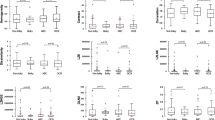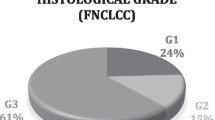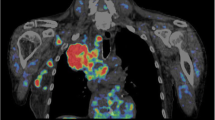Abstract
Purpose
Dynamic PET studies with 18F-FDG were performed in patients with metastatic soft tissue sarcomas who received conventional chemotherapy with doxorubicin hydrochloride (Adriamycin) and ifosfamide (AI-G). The goal of the study was to evaluate the impact of full kinetic analysis and assess its value with regard to the therapy outcome based on survival data.
Methods
The evaluation included 17 patients with 29 metastatic lesions of soft tissue sarcomas, who were treated with chemotherapy consisting of an AI-G regimen prior to high-dose chemotherapy and peripheral blood stem cell transplantation where applicable. Patients were examined prior to onset of therapy and after completion of the first cycle of AI-G. Restaging data (n = 17) based on Response Evaluation Criteria in Solid Tumors were available. Survival data (n = 14) served for reference. The following parameters were retrieved from the dynamic PET studies: standardized uptake value (SUV), fractal dimension, two-compartment model with computation of k1, k2, k3, k4 (unit: 1/min), the fractional blood volume and the FDG influx calculated according to Patlak.
Results
The mean SUV was 6.9 prior to therapy and 4.7 after one cycle. The mean influx was 0.066 prior to therapy in comparison to 0.058 after one cycle. We dichotomized the patients according to the median survival time of 320 days into response (n = 6) and non-response (n = 8). The mean SUV was 7.6 in the group of responders and 5.4 in the group of non-responders prior to therapy. Responders revealed a mean SUV of 3.8 after therapy as compared to 5.0 SUV for non-responders. We used discriminant analysis to classify the patients into the two response groups. The classification of the non-responders was generally higher (negative predictive value > 61%) than for the responders. Finally, the combined use of the four predictor variables, namely mean SUV and k1 of both studies led to the highest accuracy of 90% for both groups.
Conclusion
The data demonstrate that only a multiparameter analysis based on a combination of the absolute values of mean SUV and k1 of a baseline study and a follow-up study after completion of one cycle was the best combination for a group-based analysis, into response or non-response. The quantitative assessment of the FDG kinetics in tumours should be used to quantify the “inhibitory effect” of chemotherapy and to individualize treatment. The main effect of the AI-G therapy may be on angiogenesis (k1 effect) rather than on proliferation.



Similar content being viewed by others
References
http://www.cancer.gov/cancertopics/factsheet/sites-types/soft-tissue-sarcoma
Grobmyer SR, Maki RG, Demetri GD, Mazumdar M, Riedel E, Brennan MF, et al. Neo-adjuvant chemotherapy for primary high-grade extremity soft tissue sarcoma. Ann Oncol 2004;15:1667–72.
Strauss LG, Conti PS. The applications of PET in clinical oncology. J Nucl Med 1991;32:623–48.
Burger C, Buck A. Requirements and implementation of a flexible kinetic modeling tool. J Nucl Med 1997;38:1818–23.
Mikolajczyk K, Szabatin M, Rudnicki P, Grodzki M, Burger C. A JAVA environment for medical image data analysis: initial application for brain PET quantitation. Med Inform (Lond) 1998;23:207–14.
Dimitrakopoulou-Strauss A, Hoffmann M, Bergner R, Uppenkamp M, Eisenhut M, Pan L, et al. Prediction of short-term survival in patients with advanced nonsmall cell lung cancer following chemotherapy based on 2-deoxy-2-[F-18]fluoro-D-glucose-positron emission tomography: a feasibility study. Mol Imaging Biol 2007;9:308–17.
Miyazawa H, Osmont A, Petit-Taboué MC, Tillet I, Travère JM, Young AR, et al. Determination of 18F-fluoro-2-deoxy-D-glucose rate constants in the anesthetized baboon brain with dynamic positron tomography. J Neurosci Methods 1993;50:263–72.
Sokoloff L, Smith CB. Basic principles underlying radioisotopic methods for assay of biochemical processes in vivo. In: Greitz T, Ingvar DH, Widén L, editors. The metabolism of the human brain studied with positron emission tomography. New York: Raven; 1983. p. 123–48.
Ohtake T, Kosaka N, Watanabe T, Yokoyama I, Moritan T, Masuo M, et al. Noninvasive method to obtain input function for measuring tissue glucose utilization of thoracic and abdominal organs. J Nucl Med 1991;32:1432–8.
Dimitrakopoulou-Strauss A, Strauss LG, Mikolajczyk K, Burger C, Lehnert T, Bernd L, et al. On the fractal nature of dynamic positron emission tomography (PET) studies. World J Nucl Med 2003;4:306–13.
Schwarzbach MH, Hinz U, Dimitrakopoulou-Strauss A, Willeke F, Cardona S, Mechtersheimer G, et al. Prognostic significance of preoperative [18-F] fluorodeoxyglucose (FDG) positron emission tomography (PET) imaging in patients with resectable soft tissue sarcomas. Ann Surg 2005;241:286–94.
Kasper B, Schmitt T, Wuchter P, Dimitrakopoulou-Strauss A, Ho AD, Egerer G. The use of positron emission tomography in soft tissue sarcoma patients under therapy with trabectedin. Mar Drugs 2009;7:331–40.
Benz MR, Allen-Auerbach MS, Eilber FC, Chen HJ, Phelps ME, Czernin J, et al. Combined assessment of metabolic and volumetric changes for assessment of tumor response in patients with soft-tissue sarcomas. J Nucl Med 2008;49:1579–84.
Evilevitch V, Weber WA, Tap WD, Allen-Auerbach M, Chow K, Nelson SD, et al. Reduction of glucose metabolic activity is more accurate than change in size at predicting histopathologic response to neoadjuvant therapy in high-grade soft-tissue sarcomas. Clin Cancer Res 2008;14:715–20.
Strauss LG, Koczan D, Klippel S, Pan L, Cheng C, Willis S, et al. Impact of angiogenesis-related gene expression on the tracer kinetics of 18F-FDG in colorectal tumors. J Nucl Med 2008;49:1238–44.
Schuetze SM, Rubin BP, Vernon C, Hawkins DS, Bruckner JD, Conrad EU, et al. Use of positron emission tomography in localized extremity soft tissue sarcoma treated with neoadjuvant chemotherapy. Cancer 2005;103:339–48.
Dimitrakopoulou-Strauss A, Strauss LG, Burger C, Rühl A, Irngartinger G, Stremmel W, et al. Prognostic aspects of 18F-FDG PET kinetics in patients with metastatic colorectal carcinoma receiving FOLFOX chemotherapy. J Nucl Med 2004;45:1480–7.
Boellaard R, Krak NC, Hoekstra OS, Lammertsma AA. Effects of noise, image resolution, and ROI definition on the accuracy of standard uptake values: a simulation study. J Nucl Med 2004;45:1519–27.
Author information
Authors and Affiliations
Corresponding author
Rights and permissions
About this article
Cite this article
Dimitrakopoulou-Strauss, A., Strauss, L.G., Egerer, G. et al. Prediction of chemotherapy outcome in patients with metastatic soft tissue sarcomas based on dynamic FDG PET (dPET) and a multiparameter analysis. Eur J Nucl Med Mol Imaging 37, 1481–1489 (2010). https://doi.org/10.1007/s00259-010-1435-z
Received:
Accepted:
Published:
Issue Date:
DOI: https://doi.org/10.1007/s00259-010-1435-z




